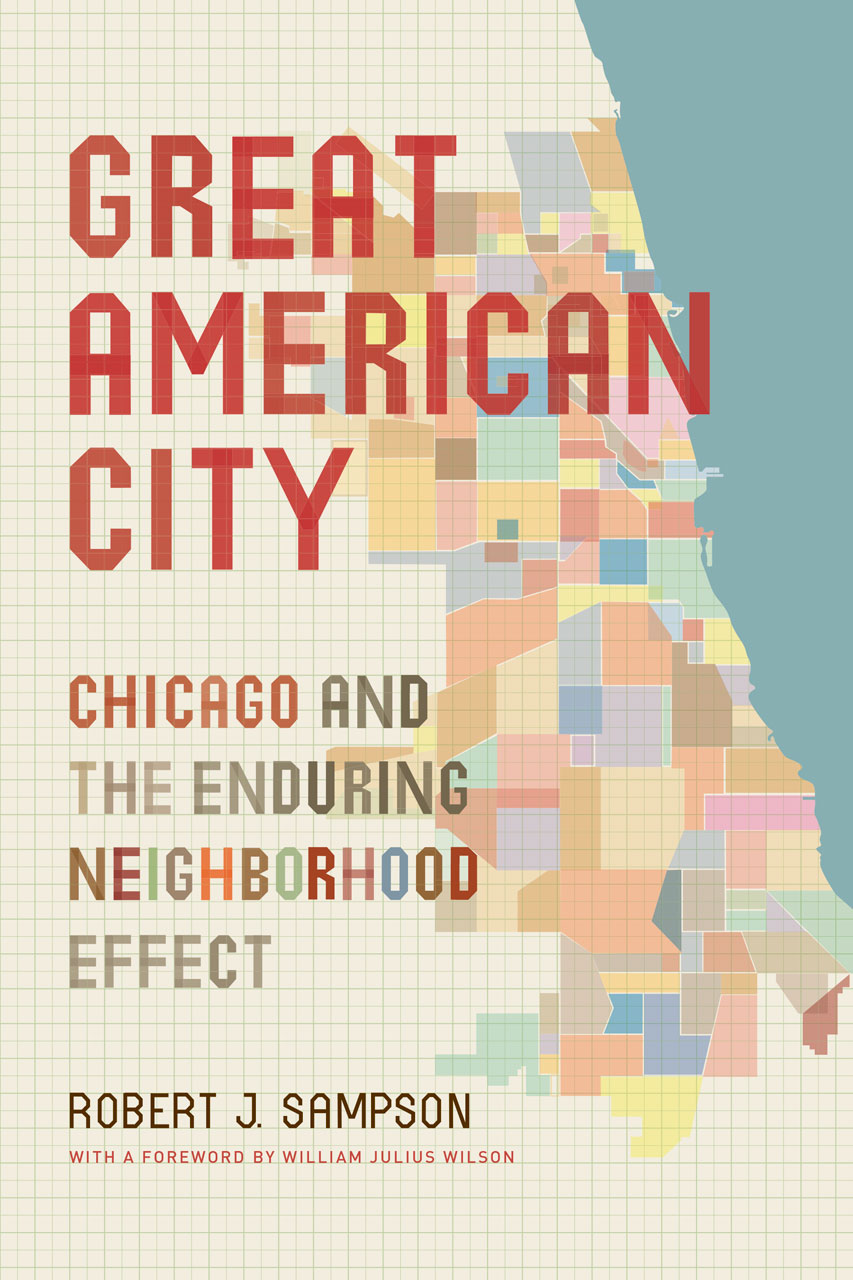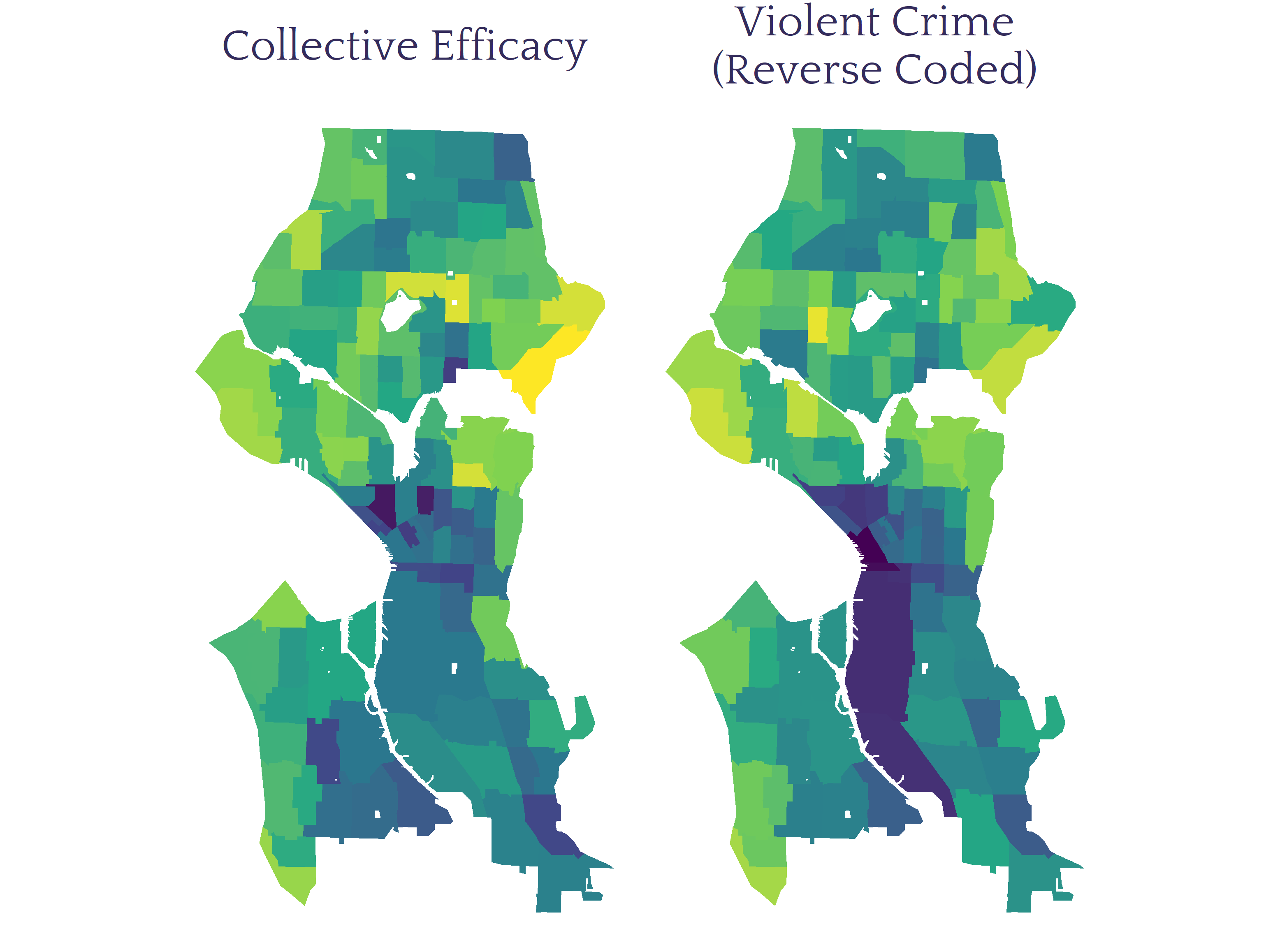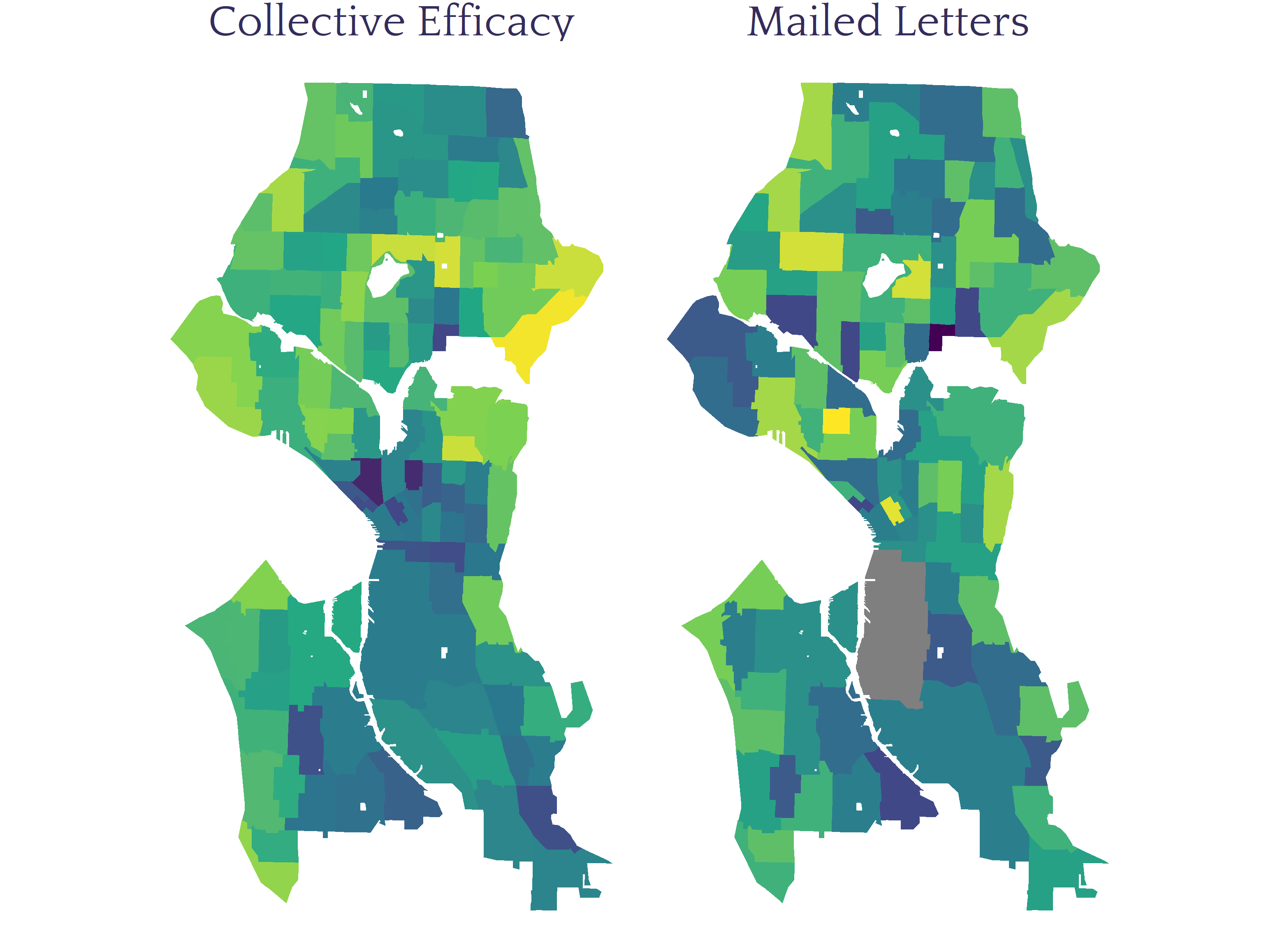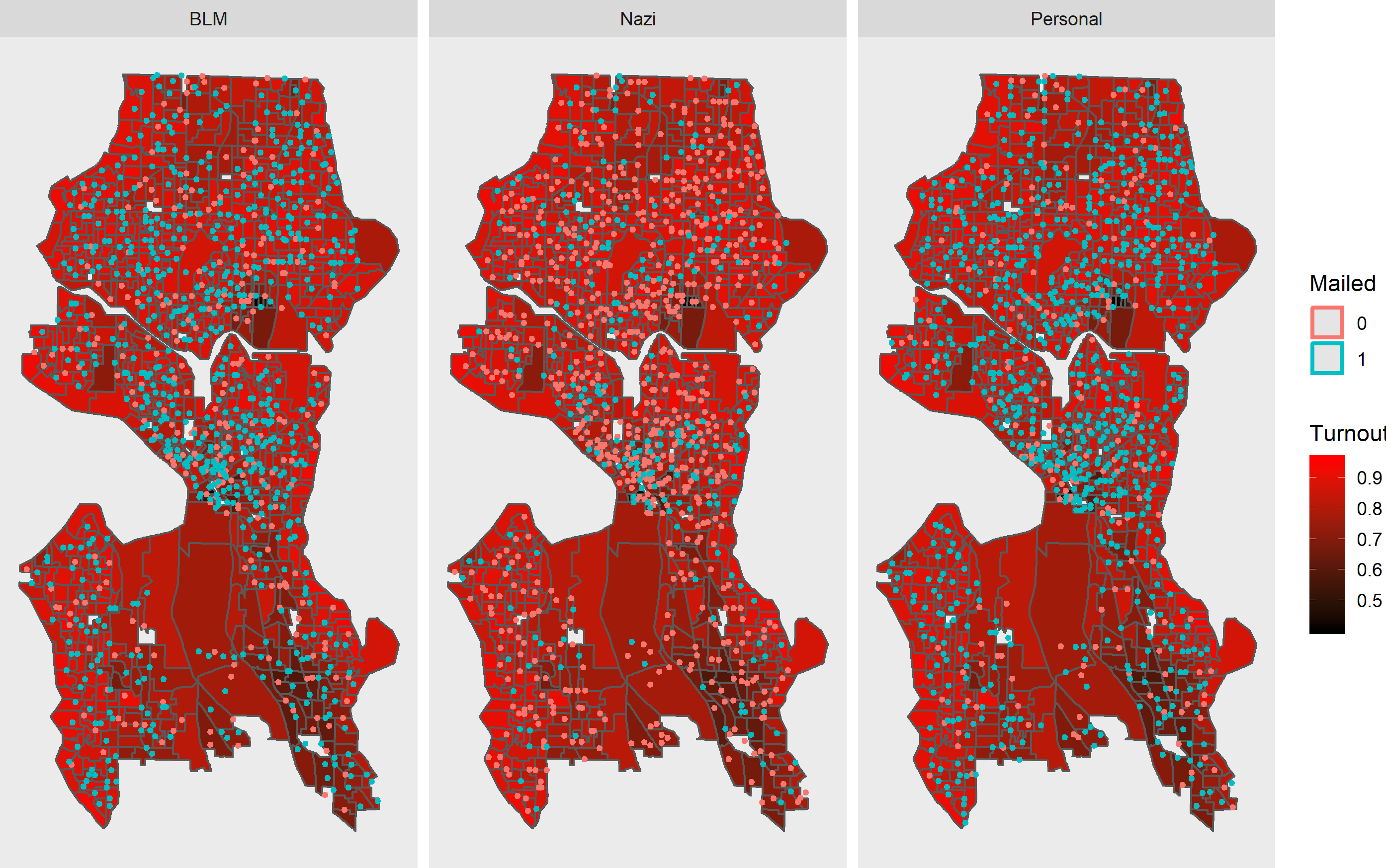class: center, top, title-slide # Social Capital and Collective Efficacy ## SOC371 ### Chuck Lanfear ### Feb 22, 2021<br>Updated: Feb 19, 2021 --- # Overview * Social capital theory * Weak ties * Closure * Forms of social capital * Free-riding, sanctions, and zeal * Collective efficacy and Community violence * Seattle Neighborhoods and Crime Project --- class: inverse # Social Capital Theory ### *A bit of background* --- # Capital * Assets (stock) collected not for intrinsic value, but for producing other goods. * Not consumed by production (but may depreciate) * More can be produced (unlike land or labor) ??? Capital increases your ability to produce goods, and those goods can often be used to acquire or produce more capital -- * Forms of capital * Physical capital (e.g. tools, buildings, roads) * Financial capital (e.g. stocks) * Human capital (e.g. skills, education) * Social Capital * Modern conception: L.J. Hanifan (1916) * Key figures: * Pierre Bourdieu * **James Coleman** * Robert Putnam ??? Classic economic capital was physical capital--plows, ships, factories. Financial capital is obligations which can be liquidated--turned into money. This is stock value. Based on collective market perception of value. Human capital is the collected skills, education, and productive capacity of individuals or groups of individuals. Social capital is a bit different: It isn't an attribute of individuals at all, but an attribute of connections between people. I'll define it shortly. Modern social capital theory in sociology (where it mainly emerged from) is associated with Bourdieu or Coleman. If you spend much time in Soc, you'll encounter both. Putnam popularized it in greater society with his book *Bowling Alone* We'll be focusing on Coleman-style social capital, as that sits at the roots of collective efficacy (Coleman overlapped at Chicago with Sampson). --- # Social Capital * Coleman: Social capital are aspects of social structure which facilitate individual *or collective* action. ??? This is broad! Any element of social structure that makes doing something easier or more likely. -- * Exists in social structure (network ties) * Attribute of collectives * Not possessed by individuals--but can be activated by them ??? Social capital cannot exist without at least two people--and the more people that are involved, the more valuable it tends to be. Individuals do not have social capital, but they can use it to get things done Imagine a favor someone owes you. That is social capital. It doesn't exist without both of you having a mutual understanding. But you can call it in to get picked up from the airport or get help burying a body. -- * Public good nature * Individuals invest, but cannot exclude * Whole network may benefit ??? Social capital is related to public goods. Public goods are things that individuals can invest in but can't prevent others from using Social capital between two people often benefits people outside that dyad--we'll get examples -- * Examples: * Weak ties and bridges * Closure of social networks * Ex: Parents of other children ??? I'll discuss some examples, then get back to definitions. --- # A Network .image-100[  ] ??? Networks are often simply drawn like this. This represents a group of people, most of whom know each other well--their ties are strong. When a group of people all know each other well, they mostly have the same information and values. This can be good for getting some things done. This might be a friend group, a department in your company, or a modestly sized cult. --- # Strength of Weak Ties .image-100[  ] ??? Weak ties are ties between acquaintances--members of other groups. Often what is most useful to people or a group is new information from unfamiliar sources. Say info about a job in a different company or neighborhood. Weak ties allow different kinds of information (like job openings) to pass between Group A and Group B The presence of a weak tie also makes the members of the groups which make that connection relatively more powerful and influential--they're brokers for information. Mark Granovetter's influential work has shown how weak ties are vital for tasks like getting a job. People with more acquantainces acquire more novel information which can benefit them. --- # Closure of Social Networks .image-100[  ] ??? Network structures like this can be directly relevant to crime control. Consider two networks describing child friends and their parents. If the parents know each other, they can share information to monitor and control their children This is the classic "I'm going to call your mom" whupping-by-proxy If parents don't know each other, the children have an information advantage--they can do things like tell each of their parents they will be at the others' house while they're out making trouble. In criminology we call this intergenerational closure--and it is a predictor of delinquency! Coleman hypothesizes that where individuals have less power in a system--such as students vs. faculty or women vs. men--the individually disadvantaged parties are more likely to form tighter networks to generate social capital to level playing field. An example he gives is networks of women sharing information about men they date. This info can facilitate generation of reputations--which can protect other women--or sanctioning via gossip and being closed out of the network. There are thus incentives for the powerful to prevent organization of the weak. Join a union. HR Departments work for your bosses and isolate the employees. --- # Types and Appropriation * Types * Obligations, expectations, trust * Information * Norms and effective sanctions ??? Obligations, expectations, and trust are tremendously powerful; Coleman's classic example is Jewish diamond traders in New York. Diamonds are highly portable and valuable and difficult to determine the exact value of. Because of the immense trust and interlocking connections of the community, traders can entrust their goods to each other freely--making everyone able to work much more efficiently. Another form combining obligations, expectations, and trust is reciprocated exchange. This is things like loaning a neighbor tools. This creates future obligations--you can borrow from them in future. Favors breed more favors. Norms and effective sanctions are social capital in Coleman's conception. Norms are expectations for behavior--which you can rely on to get things done. Sanctions--rewards and punishments--maintain norms and bring people in line with expectations. -- * Social organization can be appropriated for other purposes * South Korean study groups * Friendship networks used to deal drugs ??? Important idea: social networks and capital can be used for purposes other than those for which they were created A classic example of Coleman's is study groups of young South Korean radicals. Within high schools, churches, and small towns, existing social networks were appropriated to discuss radical political ideologies. These small cells operated effectively in secret and safety because of the pre-existing social capital--trust, personal knowledge, obligations. Only perhaps a single trusted member would ever contact other radical cells outside, limiting exposure. Another example is drug dealing that occurs via friendship networks. The ties and cohesion facilitate trust necessary for efficient and safe drug sales and transmission of information. Having a friend who "knows a guy" is appropriation of social capital for a new purpose. Social capital is important for criminal networks! --- # Externalities and Free-Riding * Social capital requires individual investment * Investment is costly * Ex: Sanctioning (Norm enforcement) ??? To enforce anti-crime norms, you need people willing to intervene and do it. Intervention costs time and energy as well habving risks of retaliation. -- * Social capital is a public good * Benefits everyone in network * Ex: Anti-crime norms and expectations to intervene ??? Many forms of social capital, like norms backed by sanctions, benefit everyone in the network. Even if you don't sanction, say, delinquent youth, you benefit from lower crime in neighborhood from others who do. This makes it a public good--something you can't selectively exclude people from. -- * Externalities * Benefits (costs) to others not considered when making choice * Generates under (over) investment ??? Public goods often suffer from underinvestment because a lot of the good produced by each individual benefits others; if they gained the full benefit, everyone would sanction. Negative externalities are very common in markets. Pollution, for instance, may harm people living near a factory--the people in the area are paying a cost that should be borne by the company instead. Many forms of regulation exist to address externalities. -- * Free-Riding * Incentive: Collect benefit, contribute nothing * System collapses if everyone does it * Second-order sanction problem ??? Primary collective action problem for social control is free-riding: You can just let everyone else take care of it. But if everyone free-rides, there will be no social control at all. We have good evidence of this in psychology and microeconomic games. Issue then is figuring out how to get people to intervene. Coleman calls this a second-order sanction problem: You may need to sanction people for not sanctioning others! Sanctions can be positive though--for instance, praising someone for intervening. Because praise is low cost to people praising, but high value to receiver, it can generate a system that very strongly reinforces generation of the public good. Coleman calls this zeal. --- class: inverse # Sampson's Collective Efficacy .pull-left[ .image-full[  ] ] .pull-right[ .image-full[  ] ] --- # Collective Efficacy * Merges social disorganization and social capital theories * Informal social control reduces crime * Social capital facilitates informal control * Social ties generate social capital -- * Collective efficacy is neighborhood capacity to achieve an intended effect * Intended Effect: Low crime and delinquency * Mechanism: (Child-centered) informal social control * Process translating latent social capital into action * Collective counterpart to Bandura's self-efficacy (individual agency) ??? Collective efficacy is a broad concept and can be used to explain many collective goals. Typically it is used to look at crime control, and mostly through child-centered social control (since most crime and deviance involves youth) In this framework, social capital--trust and cohesion in particular--are passive resources; these are the classic ties in social disorganization What matters is how these resources produce actual action--intervention against deviance This is a framework about agency--how structure facilitates individual action; it is related to Bandura's framework which describes successful actions of individuals as the result of a combination of objective capability and subjective belief in ones ability. -- * Collective efficacy inhibited by... * Heterogeneity through realization of common values * Disadvantage through deprivation of resources * Residential instability through disruption of social ties ??? Thus it looks a lot like the original social disorganization model! --- ## Social Capital & Collective Efficacy * Neighborhood social capital (collective efficacy) * Intergenerational closure * Reciprocated exchange * Trust among neighbors * Kinship/friendship ties * Voluntary associations and activism -- * Expectations for social control * Norms of intervention against deviance * Fostered by social capital (cohesion and trust) ??? Residents are likely to engage in social control when norms of appropriate behavior are clear and they feel a collective responsibility to enforce them -- * Mechanisms * Direct intervention against deviance * Internalization produces deterrence or moral conformity ??? In high collective efficacy settings, these expectations of behavior are also internalized, producing a deterrent effect or moral basis for conformity This means you can have a low crime neighborhood which stays that way because of high CE, but you may never see any social control actions --- # Operationalization * Collective efficacy is an attribute of *places* * Interested in neighborhood capacity for social control * Not directly observable: Use individuals as informants ??? The key for CE is that it is an aspect of the neighborhood It isn't directly observable either--crime can be inhibited by the capacity not the action! How do you measure this? Survey individuals, but rather than asking about what they would do against crime, ask what they think neighbords in general would do -- * Collective Efficacy * "If a group of neighborhood children were skipping school and hanging out on a street corner, how likely is it that your neighbors would do something about it?" * "If there was a fight in front of your house and someone was being beaten or threatened, how likely is it that your neighbors would break it up? ??? Two example items here, answer is in degree of agreement. Captures belief others would take action, which should be linked to both actual activity and normative expectations. If you think people would intervene, you aren't likely to do something. -- * Cohesion and Trust * "This is a close-knit neighborhood." * "People around here are willing to help their neighbors." * "People in this neighborhood share the same values." ??? This is capturing the necessary preconditions for CE. Assumption is that expectations arise in presence of social cohesion, trust, shared norms. --- ## Collective Efficacy and Crime <br> .image-90[  ] ??? Collective efficacy theory states efficacy is a mediator for structural conditions--but they still have direct effects on crime through other mechanisms. --- .image-100[  ] ??? We have CE data for Seattle! The SNCS was a 2002-2003 stratified random sample of Seattle residents netting some 5000 respondents. Included same CE measures as Sampson's PHDCN; were able to replicate much of the findings from Chicago in Seattle Still building on these today Our CE data are quite old--2003. Be nice to have more recent data but surveys are expensive. --- # Pro-Social Behavior * Collective efficacy is a general capacity to solve problems * Not just crime control * Health outcomes even ??? Net of neighborhood conditions CE is related to asthma, stress, etc. -- * Correlates with many pro-social behaviors (Sampson 2012) * Voter turnout * Administration of CPR after cardiac arrest * Returning lost letters ??? In Great American City Sampson describes two forms of prosocial behavior strongly linked to collective efficacy 3,303 mock personal letters dropped across 343 Chicago NCs -- * Updating collective efficacy using prosocial behavior ??? Because lost letter returns are highly correlated with collective efficacy, can use prosocial behavior to estimate more recent CE So we did that in Seattle --- ## Seattle Lost Letter Experiment Replication of [Milgram et al. (1965)](https://doi.org/10.1086/267344) and [Sampson (2012)](https://www.press.uchicago.edu/ucp/books/book/chicago/G/bo5514383.html). -- 2,938 letters were dropped on Seattle sidewalks for passersby to encounter. ??? This is a similar number of letters to Sampson but in a much smaller city--way higher density. -- 24 letters—8 per addressee—were dropped in each census tract: * Charles F. Landers Sr. (Personal) * Friends of Black Lives Matter (BLM) * American Neo-Nazi Party (Nazi) ??? Figured we could also test some hypotheses are same time. Vary the sender to see if it matters--this mimics Milgram, Mann, & Harter. -- Mailed letters were received at a PO Box monitored by the research team. Letters were numbered and geocoded to drop locations. ??? Receiving letters back at PO Box indicates they were mailed; also recorded condition of letter--sometimes things written on them and whatnot. Geocoded where they were dropped so we know exact spot it came from; map this to the city. --- # Lost Letter: Results .smallish[ | *Study* (Letter Address) | *Return Rate* | `\(\rho(CE)\)` |:--------------------------------|--------|------------| |*Milgram et al. (1965)*<sup>1</sup> | | | | Medical Research Associates | 70% | -- | | Friends of the Community Party | 70% | -- | | Friends of the Nazi Party | 25% | -- | |*Sampson (2012)*<sup>2</sup> | 33% | .41 | |*SNCP* (2016)<sup>3</sup> | | | | Charles F. Landers Sr. | 79% | .35 | | Friends of Black Lives Matter | 71% | .32 | | American Neo-Nazi Party | 24% | .03 | * Our results closely mimic Milgram et al. (1965). * Collective efficacy does not predict Neo-Nazi letter returns. ] .footnote[ [1] New Haven, CT; [2] Chicago, IL; [3] Seattle, WA ] ??? Study specifies which study and what specific letter addressee. Return rate is the overall proportion of letters returned of that type. The last column is the correlation between returns of that letter type and collective efficacy by neighborhood. First thing is our experiment is remarkably close in results to Milgram's original--and Seattle has way higher return rate than the Windy City (in part because of actual wind). Next finding is we have similar but slightly lower correlation with collective efficacy--but this is because our CE data are rather old! In a follow-up simple model, we estimate we capture CE quite well. Can use our lost letter as an updated or alternative CE measure. --- .image-100[  ] ??? Here is a map of CE and mailed letter rates for Seattle. They map on pretty well! Notice the university is missing on both and one area is gray on the right. We took no survey data from the University and did not do experiments in SoDo because it is weird. --- # 2016 Election Turnout .image-100[  ] ??? As a supplement, here you can see every single letter of each type as a dot (mailed vs not) over a map of voter turnout. This is mostly to show off how many we dropped but if you're good at reading ugly maps you'll see mailback rates for BLM and personal letters map on to voter turnout quite well. We predict prosocial behavior! --- ## Evidence for Collective Efficacy .pull-left[ .image-100[  ] ] .pull-right[ * Support in USA and internationally * Strong evidence in cross-section * Mixed evidence in longitudinal * Still need more research ] ??? Evidence for collective efficacy's impact on crime is fairly strong Strong evidence in cross-sectional studies across world, in particular US samples such as Chicago and US Evidence in longitudinal studies is less strong, but is evident in Chicago and Stockholm; there's been negative evidence in panels in The Netherlands, rural North Carolina, and Australia--but those tests appear underpowered. Basically what we need are strong, long time period, multi-city evaluations. --- # Outstanding Issues * What if expectations for control are based on observed crime? * Matsueda & Drakulich (2015) * What is the mechanism by which child-centered social control impacts *serious* crime? * Is there really direct intervention? * Is it reputational? * How do we build collective efficacy? * How does opportunity relate to collective efficacy? .centernote[*This is my own area of research!*] --- class: inverse # Questions --- # For Next Time * Wilson and Kelling. 1982. "Broken Windows: The Police and Neighborhood Safety." *The Atlantic Monthly*, March, pp. 29-38. * Sampson, Robert J. and Stephen W. Raudenbush. 1999. "Systematic Social Observation of Public Spaces: A New Look at Disorder in Urban Neighborhoods." *American Journal of Sociology* 105(3): 603-651. * Keizer, Kees, Siegwart Lindenberg, and Linda Steg. 2008. "The Spreading of Disorder." *Science* 322:1681-1685 Things to pay attention to: * Assumptions and causal relationships (e.g. about disorder, fear, and crime) in Wilson & Kelling (1982) * The relationship between broken windows and informal social control * Contrast in findings between Keizer et al. (2008) and Sampson & Raudenbush (1999) ??? Wilson & Kelling's piece is the origin of broken windows theory--one of most influential pieces of public crim scholarship of all time. You may be familiar with broken windows or order maintenance policing. Consider whether it actually supports those policing strategies. Sampson & Raudenbush is incredibly important AJS paper contrasting collective efficacy and broken windows. Methods are complex. Read them, but focus on theoretical setup and conclusions--the introduction and discussion / conclusion. Kezier et al. is highly influential field experiment on broken windows. We've replicated it in Seattle many times and will chat about it next time.